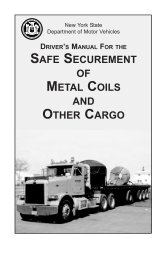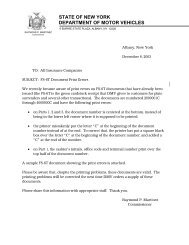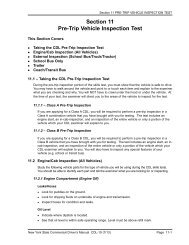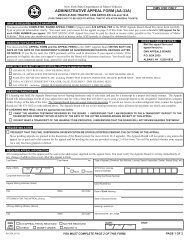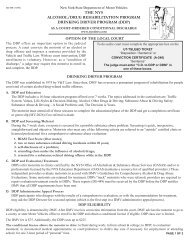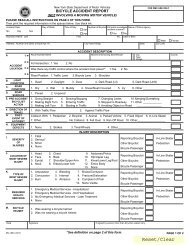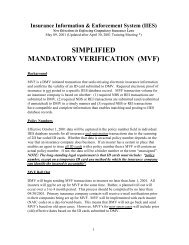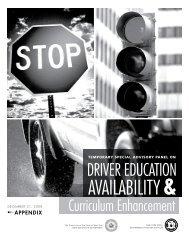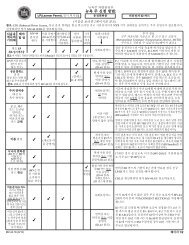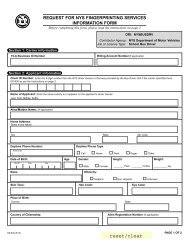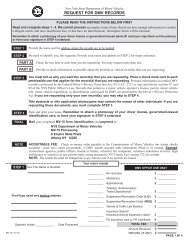Motorcycle Manual - DMV - New York State
Motorcycle Manual - DMV - New York State
Motorcycle Manual - DMV - New York State
You also want an ePaper? Increase the reach of your titles
YUMPU automatically turns print PDFs into web optimized ePapers that Google loves.
2<br />
To qualify for the waiver, the course<br />
must be given by an approved<br />
training provider in <strong>New</strong> <strong>York</strong> <strong>State</strong>.<br />
For information about the nearest<br />
MSF course, call 1-800- 446-9227.<br />
REGISTRATION,<br />
INSPECTION, INSURANCE<br />
Unlike most other motor vehicles,<br />
motorcycles are registered for one year<br />
rather than two, and all motorcycle<br />
registrations expire on April 30.<br />
<strong>Motorcycle</strong>s must be inspected at<br />
least once every 12 months at a station<br />
licensed by the <strong>DMV</strong> to perform<br />
motorcycle safety inspections. The<br />
station will display a yellow and black<br />
sign reading "Official NYS <strong>Motorcycle</strong><br />
Inspection Station." Dealerships must<br />
inspect motorcycles prior to delivery.<br />
If purchased in a private sale, you will be<br />
given 10 days from the date of registration<br />
to have the motorcycle inspected.<br />
<strong>Motorcycle</strong>s are not included in the<br />
"no fault" insurance provisions that cover<br />
other motor vehicles in <strong>New</strong> <strong>York</strong> <strong>State</strong>.<br />
Motorcyclists owners and operators<br />
should know and understand the extent<br />
and limitations of their vehicle’s<br />
insurance coverage for themselves<br />
and their passengers.<br />
Unlike other motor vehicles, liability<br />
insurance may be terminated on a<br />
motorcycle without first turning the<br />
plate in at a <strong>DMV</strong> office. This makes<br />
it easier to put the motorcycle back<br />
on the road after winter storage.<br />
However, under no circumstances<br />
may a motorcycle be operated on public<br />
highways without liability coverage in<br />
effect. This also applies to motorcycles<br />
registered out-of-state.<br />
SPECIAL RULES AND<br />
REQUIRED EQUIPMENT<br />
All motorcycle operators and<br />
passengers must wear approved<br />
motorcycle helmets as defined by USDOT<br />
federal motor vehicle safety standards<br />
(FMVSS 218). To improve the motorcyclist’s<br />
visibility, we recommend that<br />
helmets have at least four square inches<br />
of reflective material on both sides.<br />
All motorcycle operators must wear<br />
approved eye protection even if the<br />
motorcycle is equipped with a windshield.<br />
Any windshield must also be of an<br />
approved type. Prescription or made-toorder<br />
safety glasses may be used if the<br />
user can present written certification that<br />
they meet <strong>DMV</strong> standards. The eye protection<br />
must be manufactured in conformity<br />
with the regulations established by<br />
the American National Standard Institiute<br />
(ANSI - Z87.1). However, the <strong>DMV</strong><br />
recommends approved goggles or a faceshield<br />
for full protection.<br />
The headlight and taillight of the<br />
motorcycle must be on at all times when<br />
operating on the road.<br />
Motorcyclists have the right to the use<br />
of a full lane and may ride no more than<br />
two abreast in a single lane. You may not<br />
ride abreast of another vehicle in the<br />
same lane, between lanes or between<br />
traffic and parked cars. Motorcyclists are<br />
subject to all applicable rules of the road,<br />
including signaling all turns and lane<br />
changes and passing only when and<br />
where permitted for other vehicles.



